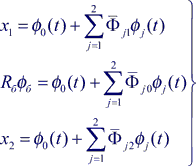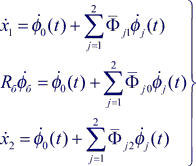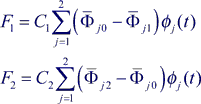The abstract on theme of master's work
The content
- Introduction
- 1. Status, purpose and objectives of the study
- 1.1 Status of matter (analysis of publications)
- 1.2 Urgency of the topic
- 1.3 Goal and objectives
- 2. Development of the mathematical model of the lifting machine
- Brief summary of the results and main findings
- List of sources
Introduction
In general complex of production processes of coal mines important place is occupied by transport and lifting, which is made by lifting machines and winches.
The main role in the development of industry in Ukraine plays the fuel and energy complex. Functioning and development of the fuel and energy complex of Ukraine is largely predetermined by the state and development of the coal industry, which is widespread in our region.
Mine winders are designed for mine hoisting equipment installations of vertical and inclined shafts, which are used to move the lifting vessels, during lifting rocks and minerals, tripping people, materials, equipment, audit and inspection of the barrel, rigging and change of hoisting balancing ropes.
Calculation of head ropes of such facilities is usually conducted by a static method, rope tension is calculated as the homogeneous rod exposed to only their own weight and cargo weight. To account for other efforts, in addition to static, take overdesigned margin, which should cover all the forces generated in the cables during lifting or lowering.
1. Status, purpose and objectives of the study
1.1 Status of matter (analysis of publications)
Questions of dynamics of lifting machines have long been in the spotlight of specialists in dynamics of machines. The paper [1] presents the basic theory and dynamics of mine hoist, contains the technical specifications and design features of elements of lifting equipment, the method of their selection and calculation. The paper [2] considers equivalent circuits and mechanical characteristics of machines and actuators, as well as studied the laws of motion machines with different mechanical characteristics. The work of Florinsky FV [3] is the basis of fundamental research in the field of applied mathematics, dynamics of machines and mechanisms.
However, some problems of mathematical modeling winders, in particular the definition of natural frequencies and mode shapes in special nodal points, require further research. The work of Florinsky F.V. [4] is the basis of fundamental research in the field of applied mathematics, dynamics of machines and mechanisms, but it is especially known for his studies of dynamic forces generated in the mine hoist ropes. In this area, he is a successor of work of his teachers - acad. A.N. Dinnik and prof. A.S. Lokshin
Established by FV Florinsky dynamic calculation theory of mine hoist ropes to date is the scientific basis for further work in this area. Issues to study the dynamics lifting machines with pulleys friction engaged prof. d.t.s Janitors V.I. [5] Naydenko I.S. [6] Sirotin S.S. [7].
1.2 Urgency of the topic
The improvement of lift systems and develop a theory of mine lifting was paid primary consideration throughout the history of mining operations by underground methods. However, despite the long and rich history of the development of the theme, the practice of design and operation of lifting equipment shows that the technical capabilities of the selected equipment are often underutilized, and the size and weight of the equipment are inflated.
Therefore, the actual problem is improving the methods of calculation and design of dynamic modes of mine hoist installations to ensure rational specifications. Construction of mathematical models of double ended elevator installation will further examine in more detail the work of its individual nodes to select their optimal characteristics. Which in its turn will increase the safety of the elevator installation, and this is particularly important when considering the passenger facilities, to optimize the performance characteristics of MSE, and explore the deterioration of the equipment from the dynamic forces for subsequent removal of the existing problems.
From this we can say that a detailed study of the dynamics of MSE would provide useful data to improve performance throughout the installation.
1.3 Goal and objectives
The aim of work is development of mathematical model of the dynamics of double ended hoisting plant.
The specified purpose can be realized by following the resolution of next local problems:
- To review and analyze literature.
- Explore the mutual movement of adjustment elements at lifting cargo.
- Analyze equivalent circuit of installation with subsequent derivation of the equations of motion.
- Develop a methodology for determining the numerical values of the natural frequencies.
- Reduce the equations of displacements, velocities and install masses to elementary formulas
- Write an expression for determining the values of the dynamic loads generated in the elastic ties - ropes.
2. Development of the mathematical model of the lifting machine
In mine conditions lifting of cargo to a height is often carried out with a special installation called winding machine with traction friction (traction sheave), in which the driving force is generated due to the forces of friction between the rope and sheave liner (drum).
One of the features of such a facility is its special equipment with equilibration rope, which is suspended from the bottom to lift vessels with masses m1 and m2 to compensate for the difference in weight plumbs of head ropes [11,12] and [13,14].

Animation consists of 13 frames with a 2 second delay between frames; the delay before repeat is 2 seconds; the number of cycles is 20. Animation size is 57,6 KB.
Figure 2.1 - Visualized scheme of the elevator installation with pulley friction
Further we consider kinematic diagram in Figure 2.1, considering the fact that the first and second mine vessels, respectively, are lift cabin and counterweight.
Presence or absence of the counterweight rope system will also be considered further.
In Lagrange equations after the necessary calculations the equations of motion systems will take the following form
:

that in a matrix form can be written as

For the general case when M and C - are symmetric matrices and eigenvectors Φj and number ωj of system we will define as

It was suggested to use a numerical method for finding the frequencies ω1, 2 on the PC, by substituting the original data model developed in the program were received following graphs of natural frequencies (Fig. 2.2) and natural modes (Fig. 2.3).
 Figure 2.2 - Natural frequencies of oscillations.
Figure 2.2 - Natural frequencies of oscillations.
 Figure 2.3 - Components of natural modes.
Further was performed operation of renormalization of natural modes (Fig. 2.4).
Figure 2.3 - Components of natural modes.
Further was performed operation of renormalization of natural modes (Fig. 2.4).
 Figure 2.4 - The renormalized own forms.
Figure 2.4 - The renormalized own forms.
Solution of the matrix equation of motion of the system elements represented in the form of an expansion in their own renormalized forms:

where the scalar coordinate of function from time can be determined by the Duhamel integral:

In connection with the unambiguous definition of the coordinate functions and constants of integration, the calculation of desired movements of left end mass the drum machine and the right end masses are reduced to the calculation on elementary formulas:

Similar expressions hold for the determination of the speeds of movement left end mass and the machine reel on the right end weight:

Dynamic forces in the elastic ties - left and right plumb of the rope on basis of the expressions displacements determined from the following equations:

Brief summary of the results and main findings
In mathematical modeling of workflows and determining natural frequencies and forms of oscillations of lifting machine may occur computational problems related to the fact that for certain values of the lift all three components of its own form corresponding to one of the natural frequencies, turn to zero. In this node a separate component of its own forms have a discontinuity of the first kind. To eliminate computational difficulties, we suggest the so-called renormalization of own forms, essence of which is the change of sign rules when passing through the node.In mathematical modeling of workflows and determining natural frequencies and forms of oscillations of lifting machine may occur computational problems related to the fact that for certain values of the lift all three components of its own form corresponding to one of the natural frequencies, turn to zero. In this node a separate component of its own forms have a discontinuity of the first kind. To eliminate computational difficulties, we suggest the so-called renormalization of own forms, essence of which is the change of sign rules when passing through the node.
The proposed mathematical model and numerical method of determination of the values of natural frequencies and forms of oscillations can be used to model workflows lifting machines, elevators, hoisting winches using the concept of “slow change” of system parameters.
Important! During writing this abstract the master's work is not yet complete. The final completion: December 2014. Full text of the work and materials on the topic can be obtained from the author or his supervisor after that date.
List of sources
- Шахтный подъем: Научно-техническое издание / Бежок В.Р., Дворников В.И., Манец И.Г., пристром В.А.; Грядущий, В.А. Корсун. — Донецк : ООО "Юго-восток, Лтд", 2007. — 624с.
- А.Г. Степанов Динамика машин. — Екатеринбург: УрО РАН, 1999. — 305с.
- Флоринский Ф.В. Динамика шахтного подъемного каната. Под ред. Савина Г.Н. М.: Углетехиздат, 1958 г. — 239 с.
- Флоринский Ф.В. Динамика шахтного подъема. Под ред. Савина Г.Н. М.: Углетехиздат, 1960 г., Москва — 179 с.
- Дворников В.И. Конспект лекций по курсу "динамика строительных" машин. — Макеевка: ДонГАСА, 2001 — 62 с.
- Найденко И.С., Белый В.Д. Шахтные многоканатные подъемные установки. Изд. 2, перераб. и доп. — М.: Недра, 1979 — 391 с.
- Сиротин С.С. Шахтные подъемные установки. Учеб.пособие. Алчевск: ДГМИ, 1997. — 174 с.
- Завозин Л. Ф. Шахтные подъемные установки. Изд. 2-е переработ. И доп. М., «Недра», 1975, — 368 с.
- Нестерова П. П. Научные основы рационального проектирования и эксплуатации элементов подъемного оборудования. К.: Н. Думка, 1978 г. — 204 с.
- Павловский М.А. Теоретическая механика. Киев "Техника" 2002, — 510 с.
- A. Stepanov, A. Koskin. A few words more on the properties of viscoelastic winding ropes. Mine hoisting`96. 8-10 October 1996, Gliwice, Poland. VOL. 2. S. 65-68.
